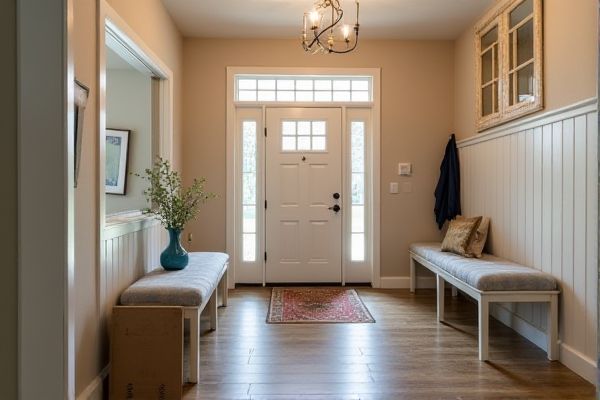
Mudroom lighting focuses on bright, task-oriented illumination to handle activities like removing shoes and organizing gear, while hallway lighting often prioritizes softer, ambient light to guide passage and enhance decor. Explore the rest of the article to understand how to choose the perfect lighting for Your home's mudroom and hallway.
Table of Comparison
| Feature | Mudroom Lighting | Hallway Lighting |
|---|---|---|
| Purpose | Illuminates entry space for removing shoes, coats, and gear | Lights passage connecting rooms and spaces |
| Brightness Level | Moderate to high for visibility and safety | Moderate for comfortable navigation |
| Fixture Types | Ceiling lights, wall sconces, task lighting | Ceiling-mounted lights, recessed lighting, sconces |
| Durability | Moisture-resistant and easy to clean | Standard fixtures, less exposure to moisture |
| Style | Functional with rugged or casual design | Varied styles from simple to decorative |
| Energy Efficiency | LED fixtures preferred for long use | LED or compact fluorescent bulbs common |
| Control Options | Switches, motion sensors for convenience | Switches, dimmers for ambiance |
Understanding Mudroom vs Hallway Spaces
Mudroom lighting requires bright, durable fixtures to handle dirt and moisture, providing clear visibility for removing shoes and storing outerwear, while hallway lighting focuses on creating a welcoming, evenly lit path connecting rooms. Your mudroom often benefits from task-oriented lights, such as recessed or LED strip lighting, whereas hallways typically use ambient sources like sconces or ceiling fixtures to enhance aesthetics. Understanding these differing needs helps optimize functionality and ambiance tailored to each space's unique role in your home.
Key Differences in Lighting Needs
Mudroom lighting requires brighter, more focused illumination to handle activities like removing shoes and storing outdoor gear, emphasizing durability and moisture resistance. Hallway lighting prioritizes softer, evenly distributed light to create a welcoming ambiance and ensure safe navigation without harsh glare. Your choice should consider these functional differences to optimize safety, comfort, and practicality in each space.
Functional Goals: Mudroom vs Hallway Lighting
Mudroom lighting prioritizes bright, focused illumination to enhance visibility for tasks like removing shoes, organizing gear, and ensuring safety in a frequently used transition space. Hallway lighting emphasizes even, ambient light to create a welcoming pathway while minimizing shadows and glare for smooth navigation. Your choice should balance practicality in mudrooms with aesthetic continuity in hallways to meet their distinct functional goals effectively.
Types of Lighting Fixtures for Each Area
Mudroom lighting primarily utilizes durable, moisture-resistant fixtures such as flush mounts, wall sconces, or LED ceiling panels designed to withstand humidity and dirt accumulation. Hallway lighting favors elegant, space-enhancing options like recessed lights, pendant fixtures, or track lighting to provide uniform illumination while complementing narrow or elongated spaces. Both areas benefit from energy-efficient LED technology but require fixture styles tailored to their distinct functional and aesthetic demands.
Ambient Lighting Strategies
Mudroom lighting emphasizes bright, durable ambient lighting to ensure visibility for tasks such as removing shoes and organizing belongings, often using ceiling-mounted fixtures or recessed lights with high lumens. Hallway lighting prioritizes softer, evenly distributed ambient light to create a welcoming transition between rooms, commonly employing wall sconces, pendant lights, or LED strip lighting to reduce shadows and glare. Selecting energy-efficient LED bulbs with appropriate color temperatures--warm white for hallways and cooler white for mudrooms--enhances functionality and ambiance in each space.
Task Lighting Solutions
Mudroom lighting often requires bright, focused task lighting to handle activities like shoe changes, coat hanging, and organizing gear, where LED strip lights and adjustable sconces provide clear visibility and reduce shadows. Hallway lighting emphasizes ambient illumination with wall-mounted fixtures or recessed ceiling lights, but task lighting can be integrated near artwork or switches for enhanced functionality. Optimal task lighting in mudrooms improves safety and efficiency, while hallways benefit from softer, more diffuse lighting to guide movement and highlight architectural features.
Accent Lighting Options
Mudroom lighting emphasizes practical accent options such as under-cabinet LED strips and wall sconces that highlight storage areas while providing sufficient brightness for tasks. Hallway accent lighting often includes recessed spotlights or picture lights that create ambient depth and highlight architectural features without overwhelming narrow spaces. You can enhance both mudrooms and hallways by selecting energy-efficient, adjustable fixtures tailored to accentuate functionality and style.
Energy Efficiency Comparison
Mudroom lighting often requires durable, moisture-resistant fixtures with bright, focused illumination, favoring LED options that provide energy efficiency and longevity in a high-traffic, potentially damp environment. Hallway lighting benefits from softer, ambient light sources such as dimmable LEDs or CFLs, which consume less energy over extended use due to lower wattage and sensor-operated controls. Choosing energy-efficient LED bulbs for both spaces can significantly reduce your home's overall electricity consumption while maintaining appropriate lighting quality for safety and functionality.
Design and Aesthetic Considerations
Mudroom lighting emphasizes practical, durable fixtures with moisture-resistant properties and warm, inviting tones to complement its functional design, while hallway lighting often features softer, ambient options to enhance flow and elegance. You should consider the spatial purpose where mudrooms demand bright, task-oriented illumination paired with rugged, easy-to-clean designs, contrasted with hallways favoring decorative elements such as sconces or pendant lights to highlight architectural details. Both lighting types influence the overall aesthetic, but mudrooms prioritize utility and resilience, whereas hallways focus on creating a transitional atmosphere that blends seamlessly with adjoining spaces.
Practical Tips for Choosing the Right Lighting
Choose mudroom lighting with bright, durable fixtures that withstand moisture and dirt, ensuring clear visibility for organizing shoes and outerwear. Opt for softer, ambient lighting in hallways to create a warm, inviting transition between rooms while preventing glare. Your selection should balance functionality and comfort, using LED bulbs for energy efficiency and selecting fixtures tailored to each space's specific use and traffic.
 homyna.com
homyna.com